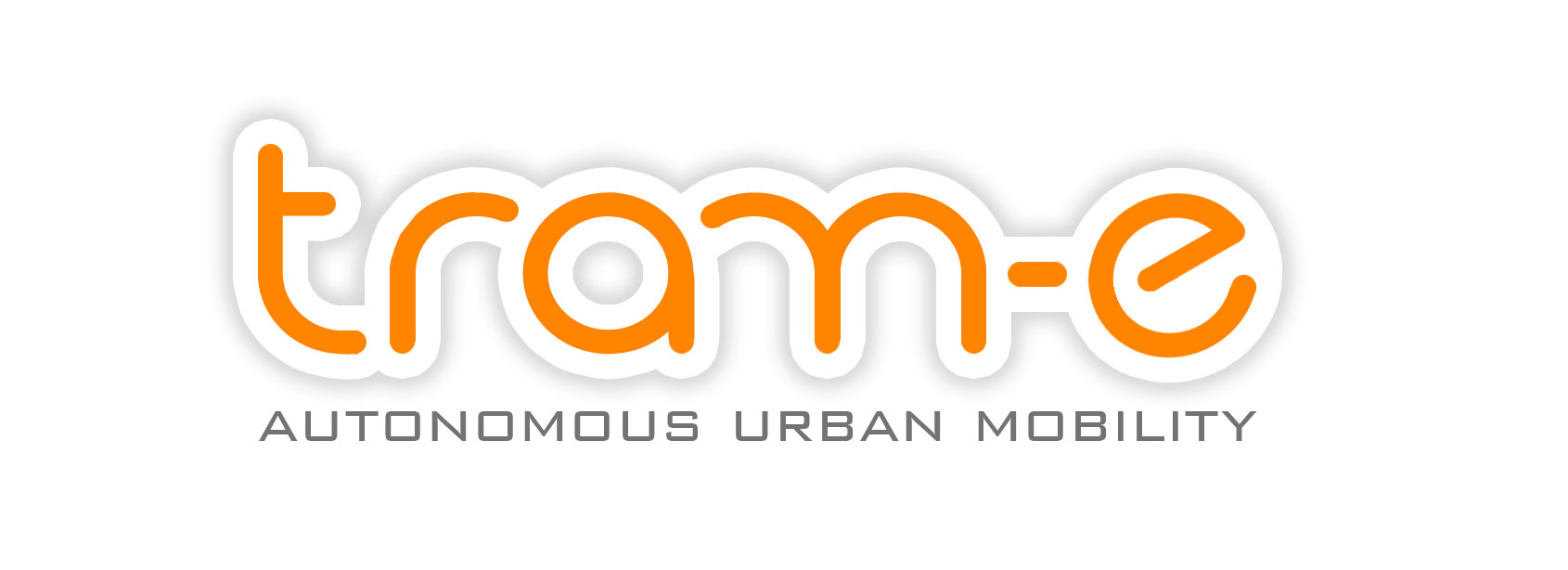


![]() Many city dwellers still use their personal cars to get around. However, only public transport offers a sustainable solution.
Many city dwellers still use their personal cars to get around. However, only public transport offers a sustainable solution.
![]() Fossil fuels are less and less accepted. But at the rate of vehicle renewal, a clean city will only be possible in several decades.
Fossil fuels are less and less accepted. But at the rate of vehicle renewal, a clean city will only be possible in several decades.
The transition of cities - necessary and wished - therefore involves the adoption of public transport that is :
![]() so economical and ecological,
so economical and ecological,
![]() so quick and easy to install,
so quick and easy to install,
![]() so comfortable for passengers,
so comfortable for passengers,
...
that any travel by individual vehicle becomes absurd, and that eventually the city will become car-free.
This is what Tram-e proposes.
Tram-e intends to participate in the necessary transition of cities by offering a means of transport:
![]() 100% autonomous (without driver)
100% autonomous (without driver)
![]() both collective (for efficiency) and individual (for comfort)
both collective (for efficiency) and individual (for comfort)
![]() environmentally friendly (zero emission of particles or CO²)
environmentally friendly (zero emission of particles or CO²)
![]() inexpensive (200 times cheaper than a subway line)
inexpensive (200 times cheaper than a subway line)
And which:
![]() integrates into existing infrastructures (unchanged pavements and sidewalks)
integrates into existing infrastructures (unchanged pavements and sidewalks)
![]() retains some of the current system (personal cars, delivery vehicles, etc.)
retains some of the current system (personal cars, delivery vehicles, etc.)
![]() promotes other green mobility (integrated cycle paths)
promotes other green mobility (integrated cycle paths)
![]() can be implemented quickly, progressively, and at any scale (single line / entire city)
can be implemented quickly, progressively, and at any scale (single line / entire city)
Tram-e is an individualised and modernised version of the tramway. Its principle is simple:
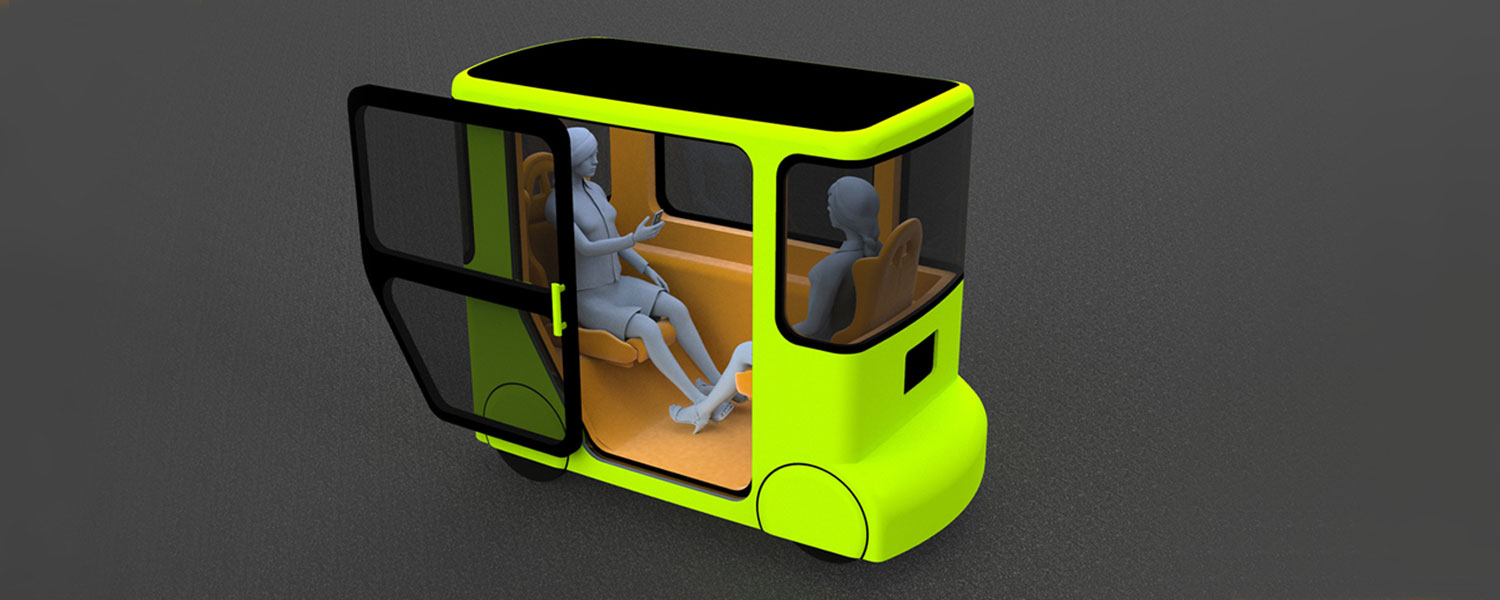
![]() Passengers are seated in pods, small individual electric vehicles.
Passengers are seated in pods, small individual electric vehicles.
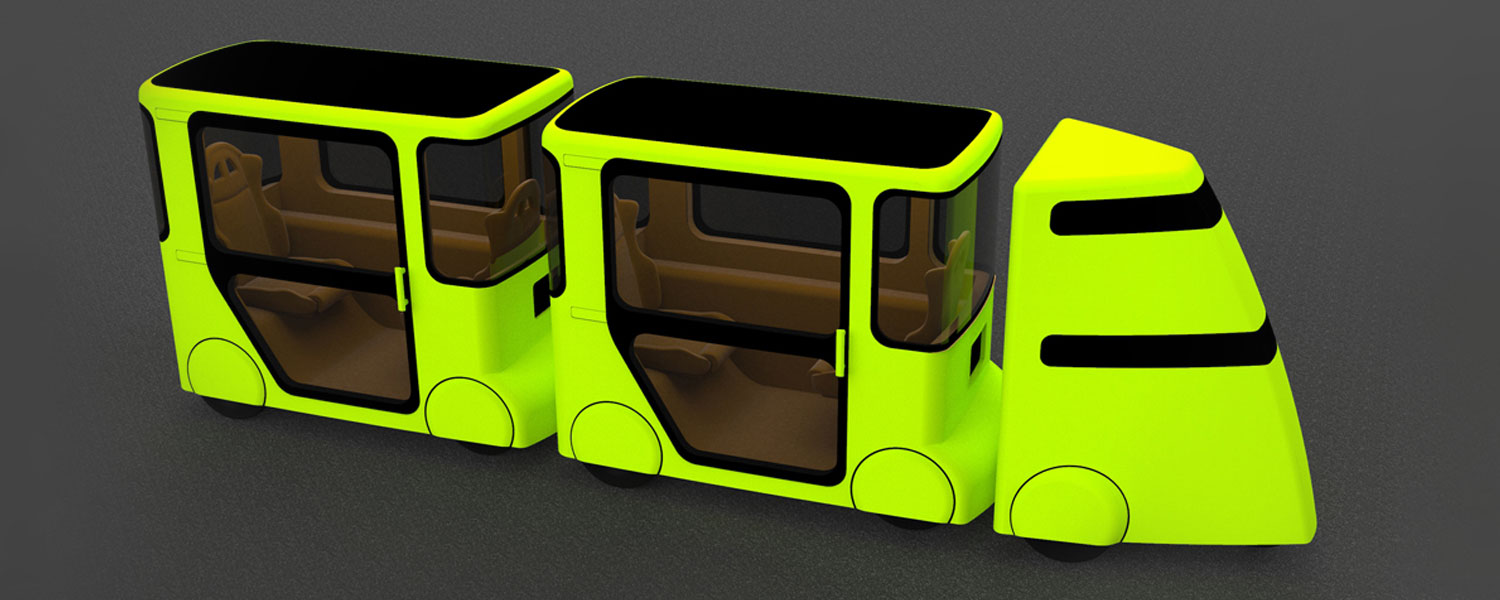
![]() During transfers, these pods are assembled to form train sets, with an autonomous locomotive at their head to manage safety.
During transfers, these pods are assembled to form train sets, with an autonomous locomotive at their head to manage safety.
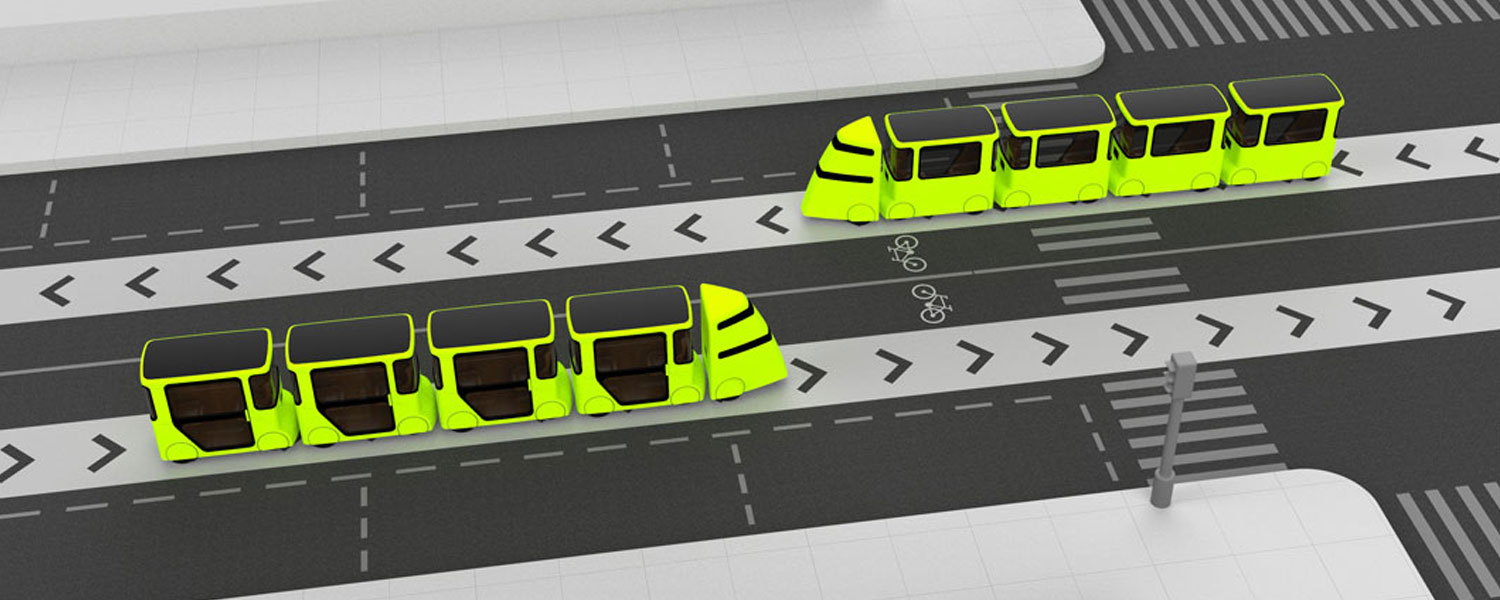
![]() These trains travel at constant speed (without stopping) along reserved streets, guided by ground markings.
These trains travel at constant speed (without stopping) along reserved streets, guided by ground markings.
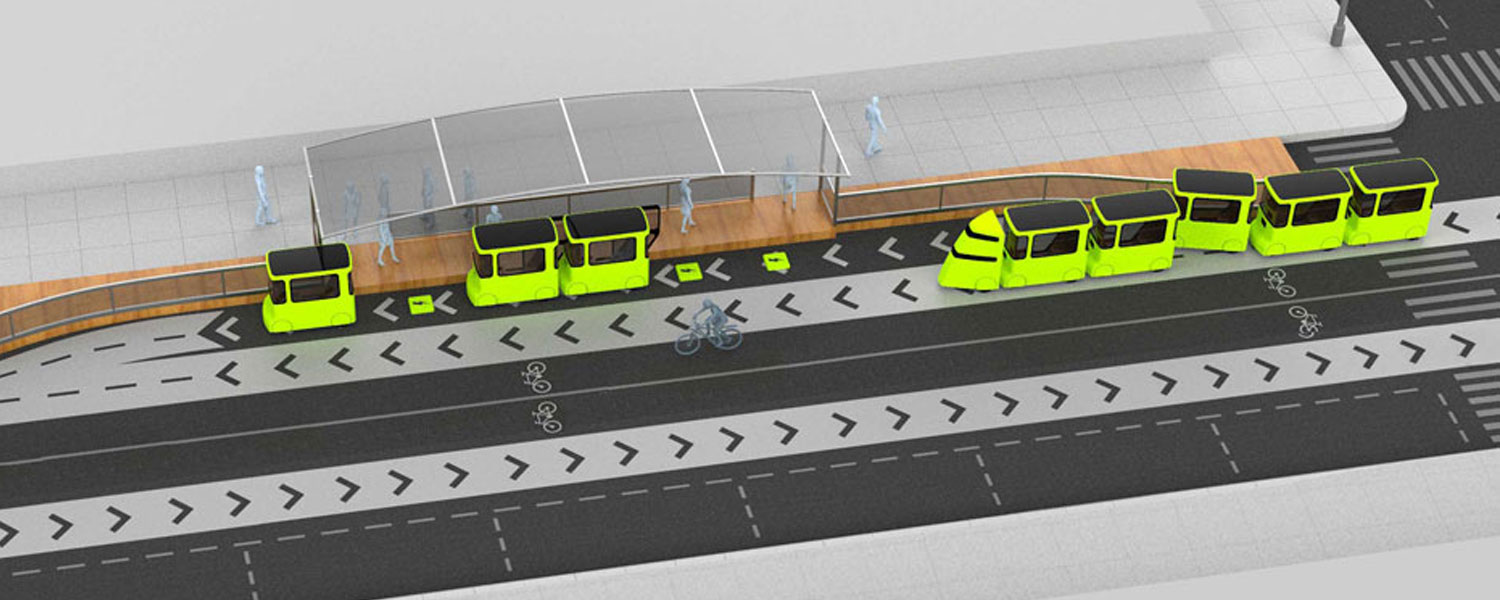
![]() Pods can be detached from the train at any time and go to a station to unload their passengers (before taking on new ones).
Pods can be detached from the train at any time and go to a station to unload their passengers (before taking on new ones).
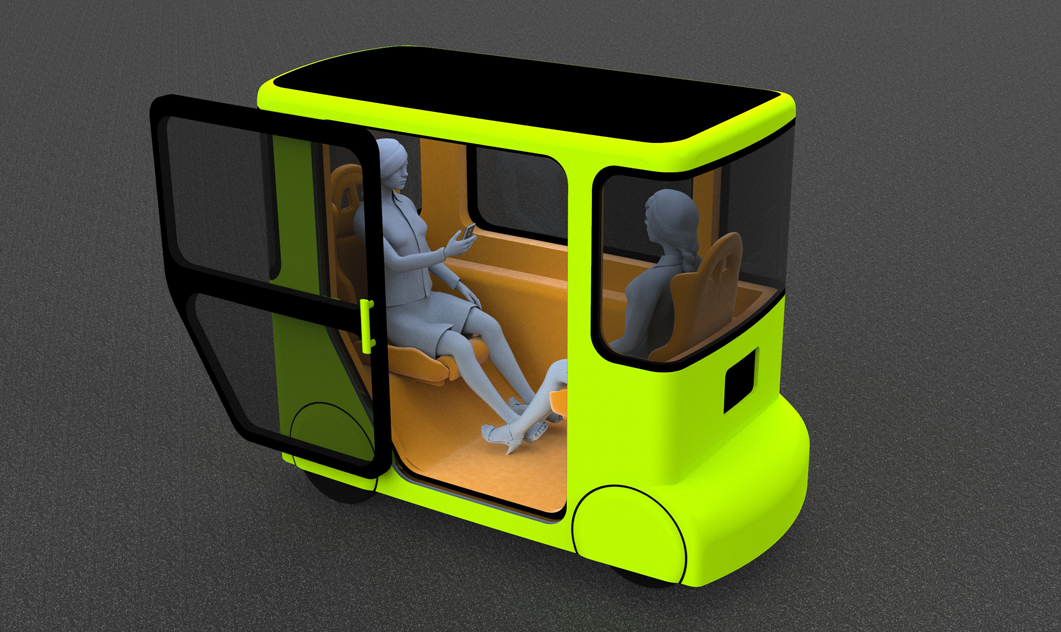
Passengers travel in individual pods (not shared with strangers). These pods can receive a choice of :
![]() One or two adults
One or two adults
![]() One adult and two children
One adult and two children
![]() One adult and a stroller
One adult and a stroller
![]() One adult with a disability (folding seats)
One adult with a disability (folding seats)
Each pod is semi-autonomous. Thanks to its batteries, electric motor and cameras, it can manage its speed and direction.
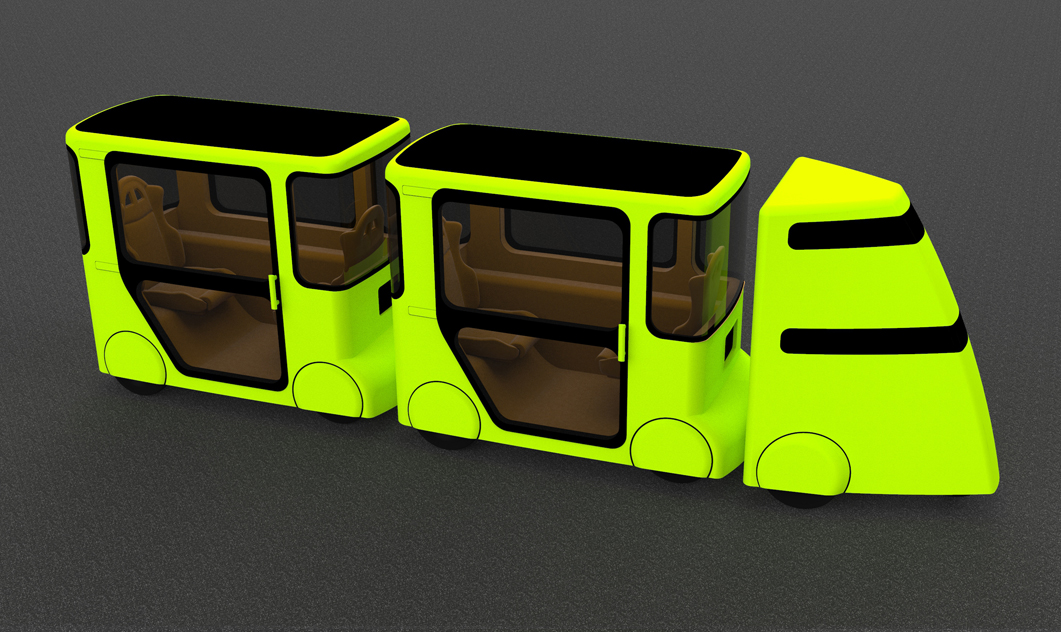
![]() The pods move in a convoy behind a locomotive which ensures their safety. They are only detached from the locomotive when approaching stations or junctions.
The pods move in a convoy behind a locomotive which ensures their safety. They are only detached from the locomotive when approaching stations or junctions.
![]() Locomotive and pods are not mechanically attached, but only in contact.
Locomotive and pods are not mechanically attached, but only in contact.
![]() Each locomotive is autonomous. Thanks to its equipment (cameras, radars, lidar), it moves along a track marker and slows down the train when risk of collision.
Each locomotive is autonomous. Thanks to its equipment (cameras, radars, lidar), it moves along a track marker and slows down the train when risk of collision.
![]() The speed of the trains is limited to 25 km/h for reasons of safety and comfort. As a reminder, the average speed in the city is 16 km/h.
The speed of the trains is limited to 25 km/h for reasons of safety and comfort. As a reminder, the average speed in the city is 16 km/h.
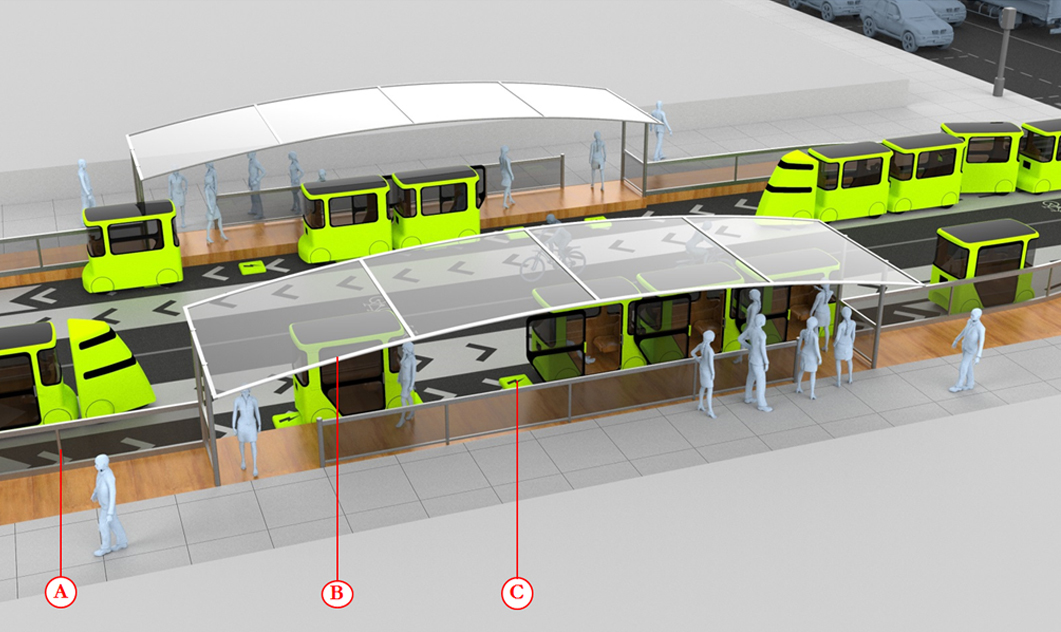
![]() TheTram-e stations consist of protective walls along the pavements
TheTram-e stations consist of protective walls along the pavements ![]() , and a shelter for waiting passengers
, and a shelter for waiting passengers ![]() .
.
![]() Thanks to the small width of the pods (only one passenger in front), the installation of the stations does not require any modification of the existing infrastructure (roadway, pavements).
Thanks to the small width of the pods (only one passenger in front), the installation of the stations does not require any modification of the existing infrastructure (roadway, pavements).
![]() Note: it is possible to add electric pylons on the carriageway
Note: it is possible to add electric pylons on the carriageway ![]() , allowing the pods to be recharged by induction. However, their autonomy theoretically allows them to reach the terminus to be recharged.
, allowing the pods to be recharged by induction. However, their autonomy theoretically allows them to reach the terminus to be recharged.
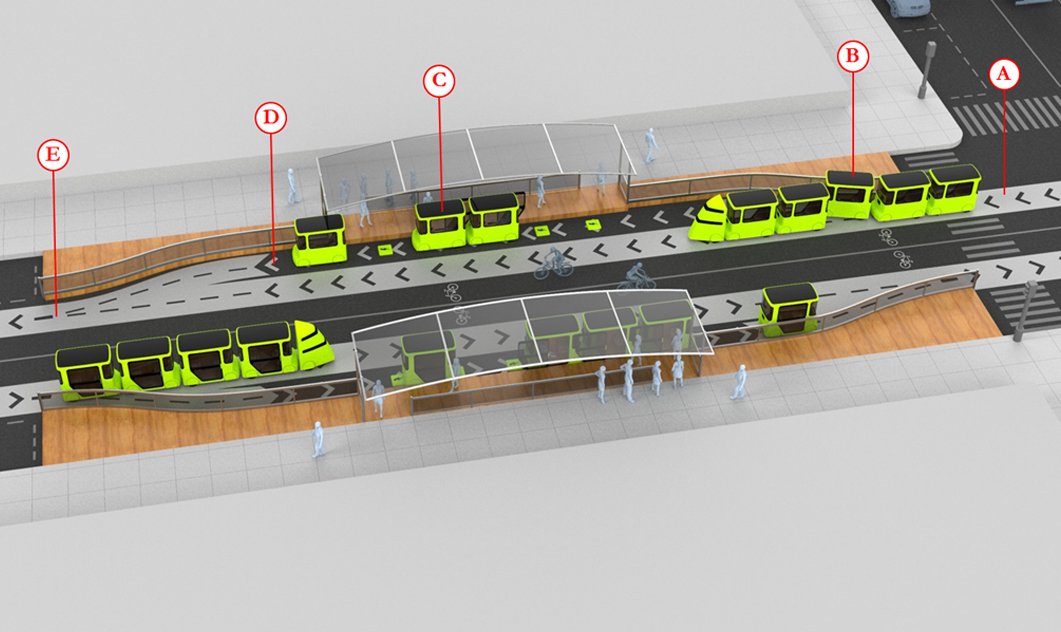
![]() The trainsets always move in a straight line, following ground markings
The trainsets always move in a straight line, following ground markings ![]() .
.
![]() When approaching a station, each pod can detach itself from the train
When approaching a station, each pod can detach itself from the train ![]() , branch off on a parallel track, then stop at the station to drop off its passengers
, branch off on a parallel track, then stop at the station to drop off its passengers ![]() .
.
![]() Once new passengers are on board, the pod is placed in a waiting area
Once new passengers are on board, the pod is placed in a waiting area ![]() . As it approaches the next train, it launches out and hangs on to the rear of the new train
. As it approaches the next train, it launches out and hangs on to the rear of the new train ![]() .
.
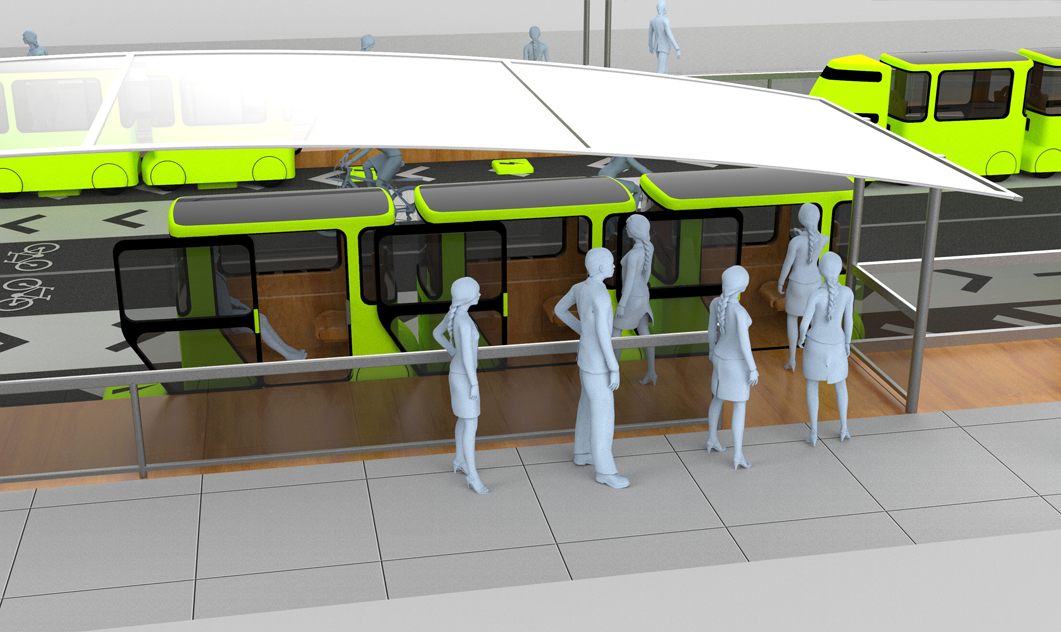
![]() Pods are self-service 24/7. Their reservation is done thanks to a smartphone application and a QR code reader installed in each pod.
Pods are self-service 24/7. Their reservation is done thanks to a smartphone application and a QR code reader installed in each pod.
![]() Borrowing a pod is very simple:
Borrowing a pod is very simple:
![]() The passenger enters their destination in the dedicated mobile application, which generates a QR code.
The passenger enters their destination in the dedicated mobile application, which generates a QR code.
![]() The passenger joins one of the pods waiting in the station, gets on board and then scans the code.
The passenger joins one of the pods waiting in the station, gets on board and then scans the code.
![]() The pod starts and automatically manages the journey*.
The pod starts and automatically manages the journey*.
![]() On arrival at the destination station, the passenger gets off; his or her journey is automatically regulated.
On arrival at the destination station, the passenger gets off; his or her journey is automatically regulated.
*: unlike the subway or bus, line changes are managed automatically; between departure and arrival, the passenger never leaves the pod.
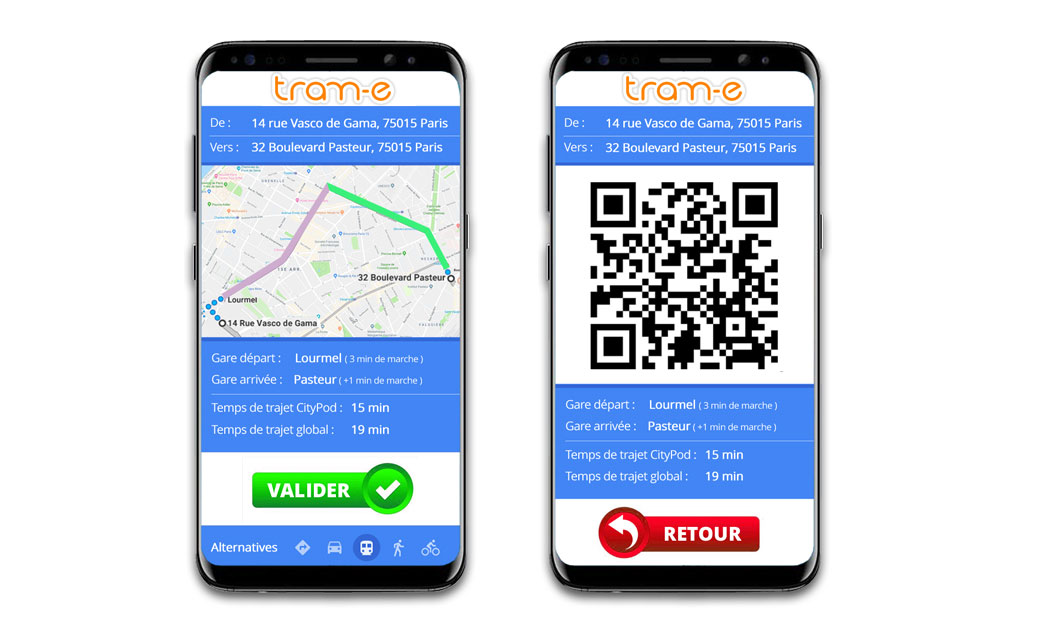
Note:
Tram-e uses technologies already proven/mastered by major companies, as Valéo for 48V engines/electronics, Navya or Easymile for autonomous shuttles, JCDecaux for stations, etc.
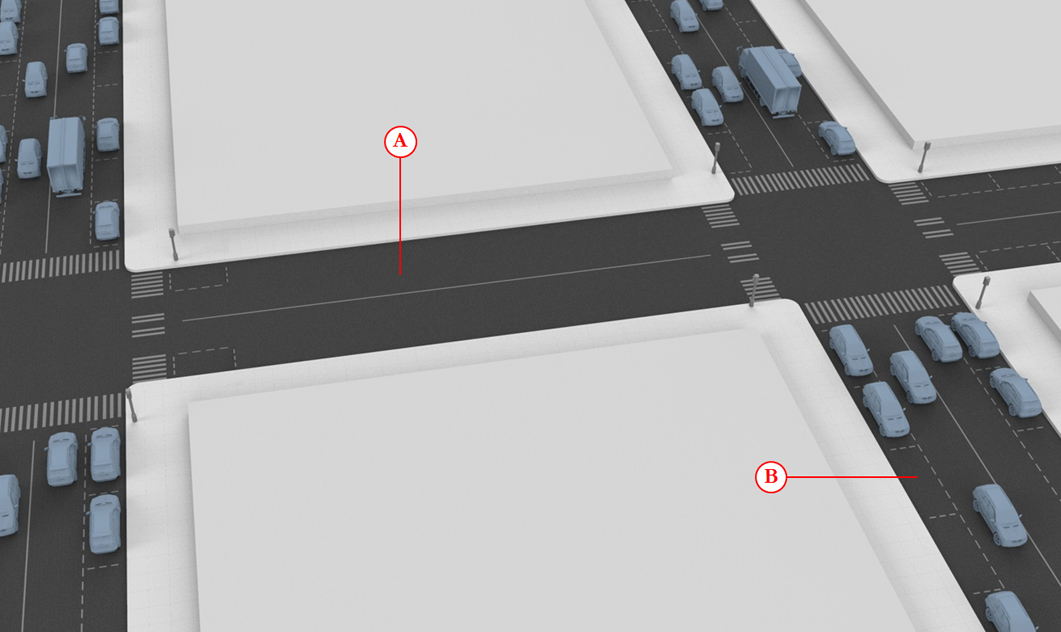
The axes where Tram-e ![]() is to be implanted are reserved. Traffic and some parking spaces are eliminated (only emergency, police and delivery vehicles are allowed to use them in exceptional cases).
is to be implanted are reserved. Traffic and some parking spaces are eliminated (only emergency, police and delivery vehicles are allowed to use them in exceptional cases).
In non-reserved streets ![]() , the circulation and parking of private cars remains possible.
, the circulation and parking of private cars remains possible.
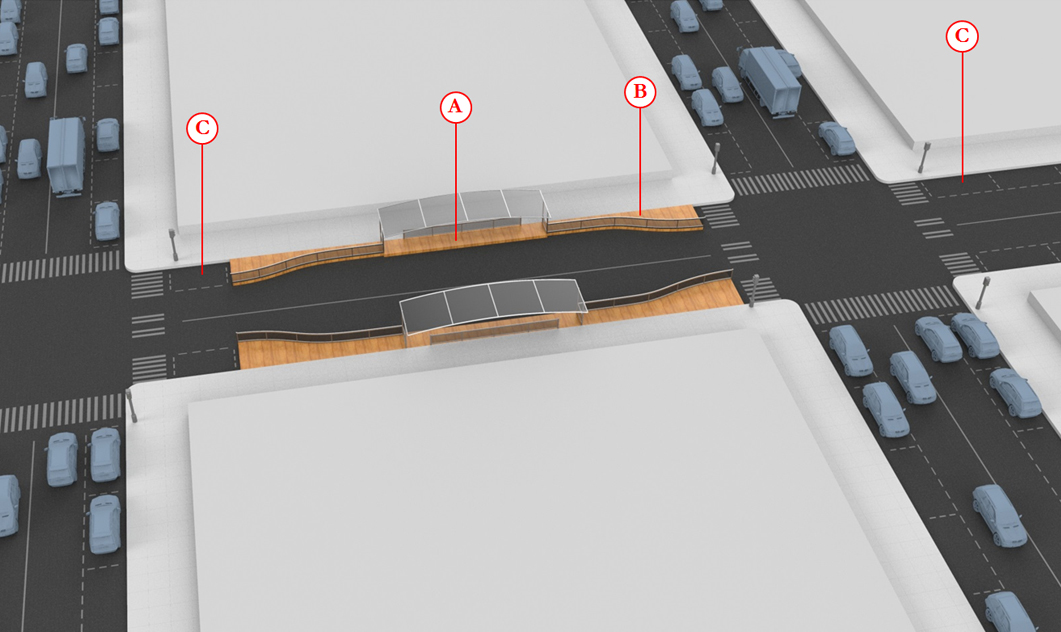
The stations ![]() , prefabricated upstream, are installed in a few hours along the pavements.
, prefabricated upstream, are installed in a few hours along the pavements.
The installation of these stations does not affect existing buildings or pavements. Their surface area is even increased ![]() (which allows the installation of bicycle or scooter stations, for example).
(which allows the installation of bicycle or scooter stations, for example).
It should be noted that parking spaces ![]() are still available for deliveries.
are still available for deliveries.
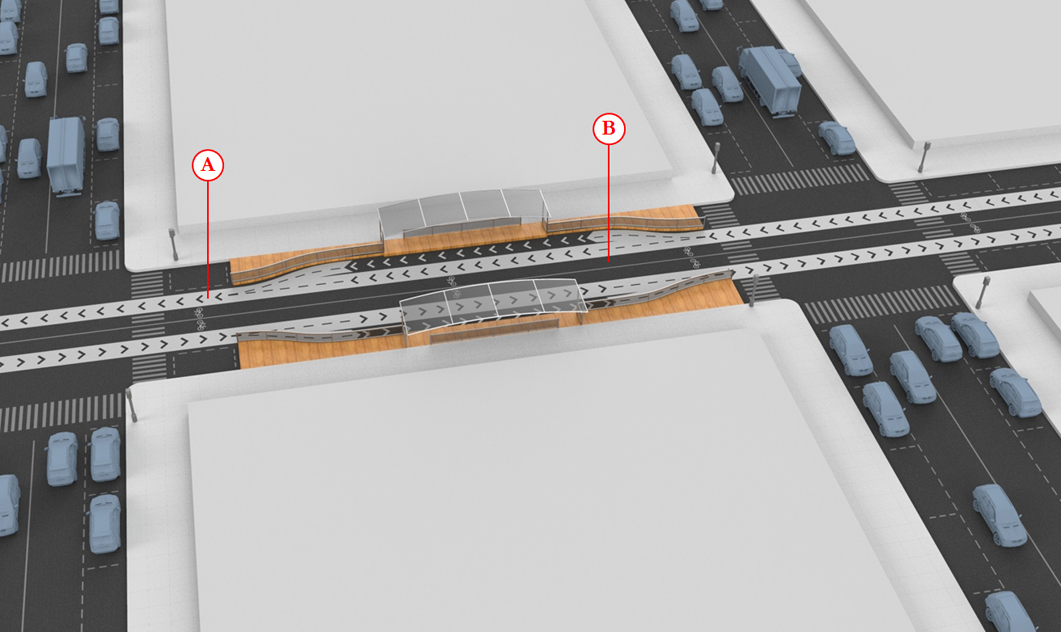
Locomotives and Pods move following ground markings. These markings delimit corridors ![]() reserved for trains.
reserved for trains.
It should be noted that thanks to the narrowness of the pods, it is possible to create permanent cycle paths in the centre of the streets ![]() .
.
Note: the example opposite shows a two-way installation in a narrow street. Police, fire brigade or delivery vehicles can circulate there, but with caution. In the case of wider streets, a lane may be reserved for them.
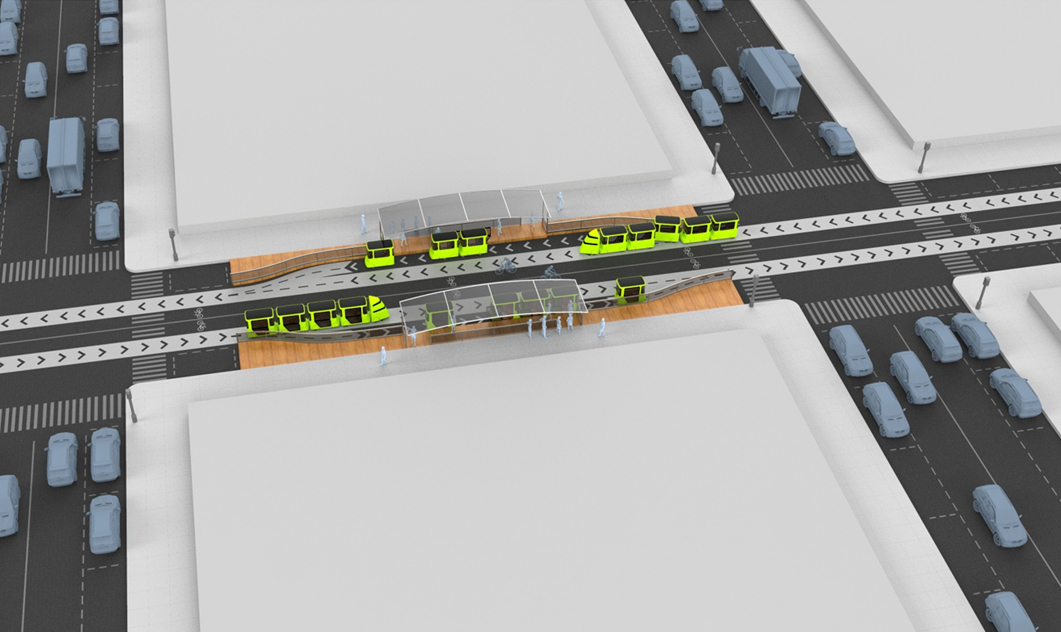
All set. Tram-e can be launched. The work will have taken only a few days. If needed, the process can be reversed, and Tram-e can be removed in a few hours.
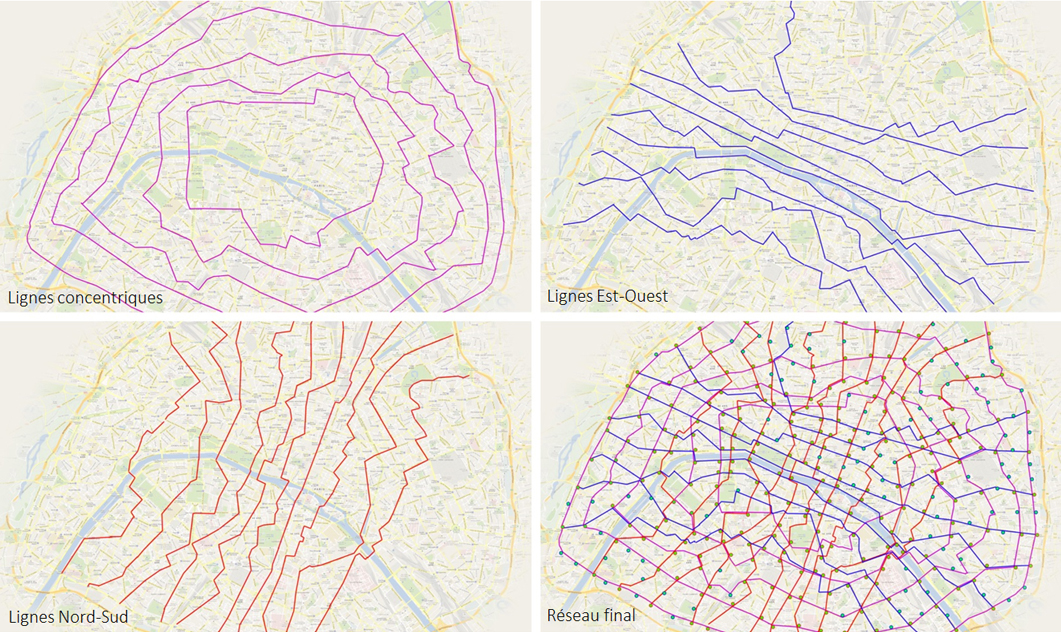
Tram-e can be installed progressively and at any scale.
A single line from point A to point B can be justified in itself.
But it is also possible to install Tram-e on the scale of an entire city, by creating a network of single lines, connected by intersections (like the Parisian metro).
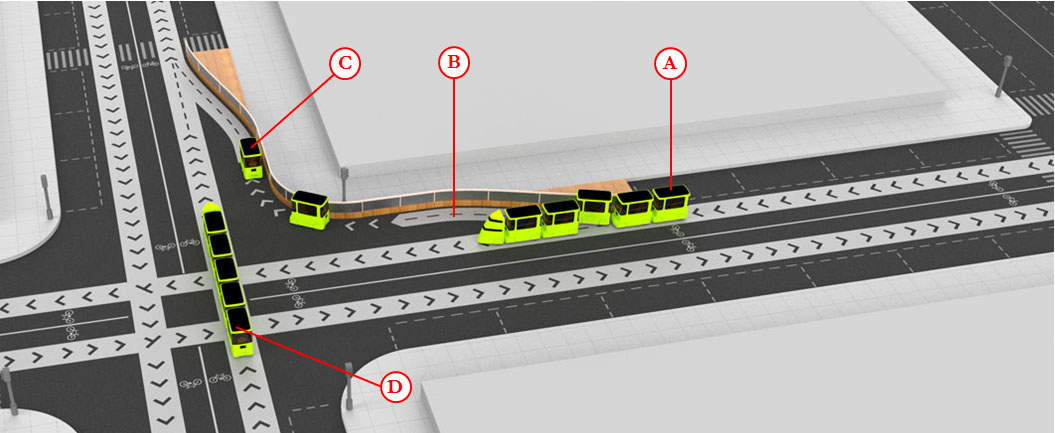
Case of a junction without a station
![]() An oar
An oar ![]() approaches a crossroads.
approaches a crossroads.
![]() The locomotive and most of the pods continue straight ahead and cross the intersection.
The locomotive and most of the pods continue straight ahead and cross the intersection.
![]() Pods that have to change lines branch off the track
Pods that have to change lines branch off the track ![]() , slow down and come to a stop at the point
, slow down and come to a stop at the point ![]() .
.
![]() A perpendicular train
A perpendicular train ![]() arrives. As soon as it has passed the waiting pods
arrives. As soon as it has passed the waiting pods ![]() , the pods start to move and come to rest at the end of the train.
, the pods start to move and come to rest at the end of the train.
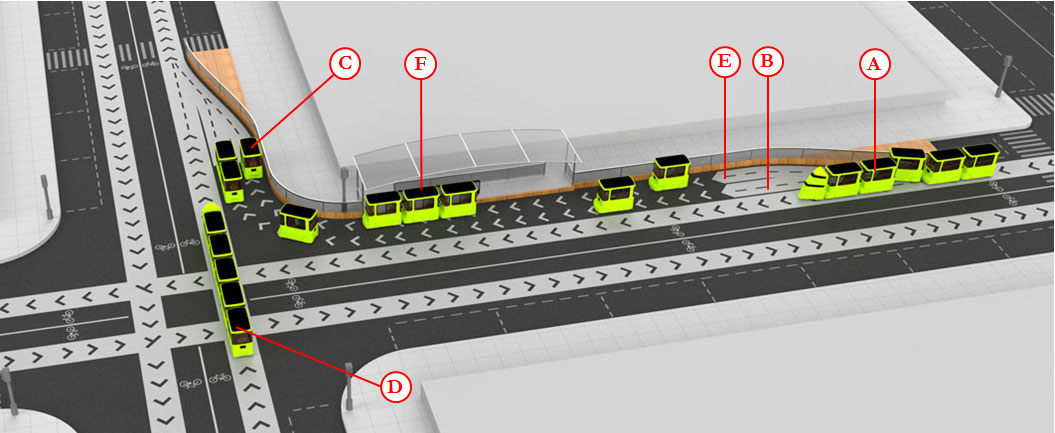
Case of a crossroads with a station
Same as before, except:
![]() Pods that have to stop at a train station branch off the track
Pods that have to stop at a train station branch off the track ![]() .
.
![]() They stop in the station,
They stop in the station, ![]() , drop off their passengers, pick up new ones, and go to the pods waiting at the point
, drop off their passengers, pick up new ones, and go to the pods waiting at the point ![]() .
.
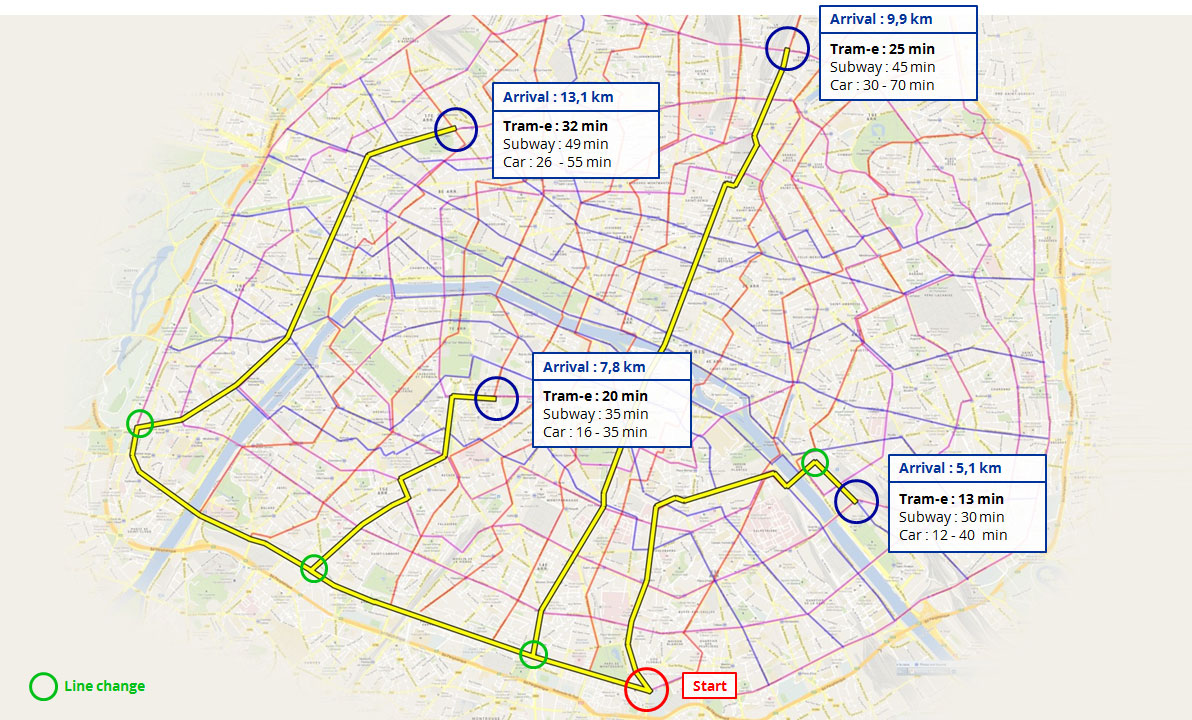
Going from point A to point B without ever turning left and changing lines only once is possible thanks to the mesh network.
The speed of the trains is limited to 25 km/h, but in the absence of any stops (with the exception of the sometimes necessary change of line), journey times remain very short.
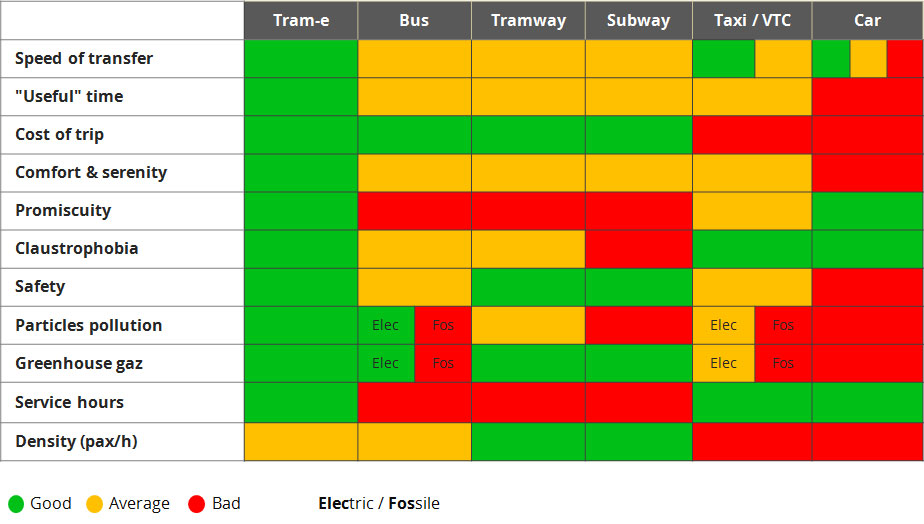
Comparison with current collective solutions

Example of cost for a 5 km single Tram-e line, round trip (in euros)

![]() A more beautiful and serene city, which is becoming more and more attractive to tourists.
A more beautiful and serene city, which is becoming more and more attractive to tourists.
![]() A revaluation of real estate and shops (silence, practicality)
A revaluation of real estate and shops (silence, practicality)
![]() More space for leisure, shops
More space for leisure, shops
![]() Buildings less degraded by pollution
Buildings less degraded by pollution
![]() Better health and less stress for residents
Better health and less stress for residents
As for the benefits for the planet, they are obvious in terms of combating pollution and global warming.

The Tram-e concept was developed by Fabrice Doléac, engineer, designer and car enthusiast. A former employee of Renault, Décathlon and Dassault Systèmes, then co-founder of Selfcair, he designs innovative mobility solutions adapted to a sustainable world.
![]() Présentation générale (pdf - 4Mo)
Présentation générale (pdf - 4Mo)
![]() Présentation courte (one pager) (pdf - 0,3Mo)
Présentation courte (one pager) (pdf - 0,3Mo)
![]() What is the interest of Tram-e compared to the autonomous shuttles that are currently being tested?
What is the interest of Tram-e compared to the autonomous shuttles that are currently being tested?
Autonomous shuttles also have a predefined route but, unlike Tram-e, they carry passengers who do not know each other and do not have the same final destination. The latter therefore have to manage their journey themselves, especially when changing lines. In addition, the shuttle has to stop regularly to drop off or pick up passengers, which slows down its operation and reduces comfort (accelerations/brakes, cold and draughts in winter, etc.).
Nothing like that with Tram-e: you are alone on board, or in the company of relatives; you arrive directly at your final destination without worrying about the journey; and you get there in record time. Finally, thanks to their much lighter weight, Tram-e pods carry simplified electrical technology which allows you to lower costs while increasing safety.
![]() What security for autonomous transport?
What security for autonomous transport?
Full autonomy (level 5) has been the subject of incessant research for several years. On open roads and without predefined routes, this autonomy is still a utopia and will require very complex and expensive equipment in any case.
But Tram-e is different: the trains travel on a defined and marked route, without changing lanes, in a relatively safe area (no cars) and at a limited speed. In this case, self sufficiency is already a reality. Hundreds of factories already use autonomous vehicles guided by markings, capable of stopping in the event of a risk of collision. In order to limit train costs, pods are not 100% autonomous - only locomotives are.
![]() What are the advantages of Tram-e for passengers?
What are the advantages of Tram-e for passengers?
Ils sont très nombreux. La vitesse de déplacement est inégalée, tout comme la sécurité (même si vous avez trop fait la fête). Le confort est unique : vous voyagez seul ou avec un proche, assis façon lounge avec des ports USB à votre disposition pour travailler ; vous arrivez à votre destination sans avoir à effectuer de changements de ligne, ni subir d'arrêts intempestifs. En un mot, vous voyagez dans votre propre bulle confortable qui vous emmène à destination, sans aucun stress.
L'idée générale est d'offrir un tel confort que tout déplacement en véhicule particulier deviennent absurde, que progressivement les citadins choisissent de se débarasser de leurs voitures, et que la ville devienne un havre de calme et de sérénité.
![]() Batteries: locomotives and pods have their own low-capacity batteries (7 kWh for a range of 60 km), which can be recharged in a few minutes at the terminus and/or at the station for the pods.
Batteries: locomotives and pods have their own low-capacity batteries (7 kWh for a range of 60 km), which can be recharged in a few minutes at the terminus and/or at the station for the pods.
![]() Autonomy: acceleration and speed are crucial factors. Thanks to a low (25 km/h) and constant speed (a slight deceleration may be necessary in order to allow a train to pass perpendicular to the approach of a crossroads), energy consumption remains very low.
Autonomy: acceleration and speed are crucial factors. Thanks to a low (25 km/h) and constant speed (a slight deceleration may be necessary in order to allow a train to pass perpendicular to the approach of a crossroads), energy consumption remains very low.
![]() Regenerative braking: it enables the batteries of the pods to be recharged when braking (increased autonomy) but also avoids the emission of dangerous fine particles (the conventional brakes, although present, are only used in an emergency). Similarly, the weight contained in the pods limits tyre wear, which is also a source of pollution.
Regenerative braking: it enables the batteries of the pods to be recharged when braking (increased autonomy) but also avoids the emission of dangerous fine particles (the conventional brakes, although present, are only used in an emergency). Similarly, the weight contained in the pods limits tyre wear, which is also a source of pollution.
![]() 48 volt voltage: thanks to the reduced weight of the vehicles, the electrical system can be limited to 48V. This induces perfect safety (no risk of electrocution), and reduced manufacturing and maintenance costs.
48 volt voltage: thanks to the reduced weight of the vehicles, the electrical system can be limited to 48V. This induces perfect safety (no risk of electrocution), and reduced manufacturing and maintenance costs.
![]() The roof of the pods can be equipped with photovoltaic cells to gain autonomy.
The roof of the pods can be equipped with photovoltaic cells to gain autonomy.
![]() An optional camera can be installed inside the pods to ensure passenger safety and/or avoid damage.
An optional camera can be installed inside the pods to ensure passenger safety and/or avoid damage.
![]() The opening and closing of the pod doors can be automated.
The opening and closing of the pod doors can be automated.
![]() Once the technology is perfected, the pods can become autonomous. Locomotives will then no longer be necessary, and passengers will be able to board and alight from pods outside stations (although the pods can be kept for induction recharging).
Once the technology is perfected, the pods can become autonomous. Locomotives will then no longer be necessary, and passengers will be able to board and alight from pods outside stations (although the pods can be kept for induction recharging).
